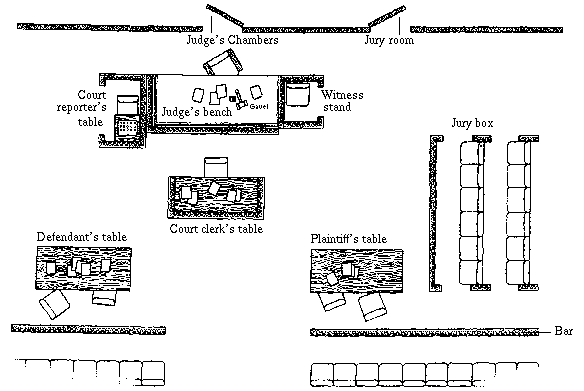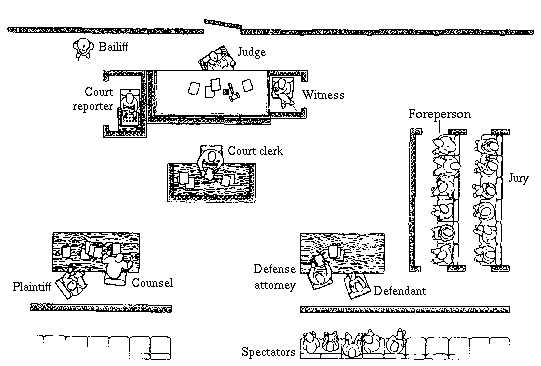All About Court

Courts of law are the umpires of the American legal system. Two types of cases are taken to court, civil and criminal. Civil cases usually deal with disagreements about people's rights and duties toward one another. Criminal cases are brought by the government (either state or federal) against people accused of committing crimes. All courts have the same set and cast of characters. Take your seat for the courtroom drama.
Setting the Scene
 Sara Mintz Zwicker |
Judge's chambers: A small room off the courtroom where the judge changes into robes and confers with lawyers. Jury room: A room outside the courtroom where the jury deliberates. Bar: A fence-like barricade that separates the spectators from the court.
Cast of Characters
 Sara Mintz Zwicker |
| Bar examinations are given to law school graduates before they may try a case in court. Once they pass the exam, the new lawyers are permitted to stand before the bar in the courtroom and try a case. |
Bailiff: The police officer who maintains order in the court.
Counsel: A name for the lawyer engaged in the trial. Both the plaintiff and the defendant have counsel.
Court clerk: The person who helps with administrative duties and stores the physical exhibits introduced as evidence at the trial.
Court reporter: A person who types every word said during the trial. The typewritten document is a permanent record of the trial.
Defendant: The person who is accused of a crime and is being tried.
Defense attorney or public defender: The lawyer who defends the accused person. A public defender is appointed if the accused is unable to pay for an attorney.
Foreperson: The foreperson of the jury speaks for the entire jury.
Grand Jury: A group of people who decide whether or not there is enough evidence to formally accuse someone of a crime.
Judge: The legal officer who presides over the courtroom and directs and controls the trial.
Plaintiff: The person who accuses another and brings the lawsuit to court.
Prosecutor: A public official who brings the government's case against a person accused of a crime and asks the court to convict that person.
Trial Jury: Usually made up of six to twelve people, the jury listens to testimony from both the plantiff and defendant's side and decides the verdict of a case.
Witness: A person who gives the jury information about the case.
Words from the Script
Acquittal: A legal determination that a person who has been charged with a crime is innocent.
Appeal: A request for a higher court to review a decision made by a lower court.
Arraignment: When the accused is brought before the court to hear the charges against the person to plead guilty or not guilty
Conviction: The result of a criminal trial in which a person is found guilty.
Cross-examination: The questioning of a witness by the lawyer for the opposing side.
Direct-examination: The first questioning in a trial of a witness by the lawyer who called that witness.
Indictment: An accusation of a crime, made against a person by a grand jury upon the request of a prosecutor.
Information: An accusation of a crime, made against a person by the prosecutor.
Mistrial: A trial that becomes invalid, is essentially canceled, because of a mistake in procedure.
Motion: How a lawyer asks the judge to make a decision.
Objection: The opposing side finds fault with the question being asked the witness.
Overruled: The judge, following an objection, decides the questions may continue.
Sentence: The punishment given to a person who has been convicted of a crime.
Sustained: The judge, following an objection, agrees that the line of questioning should not continue.
Verdict: A verdict of guilty or not guilty is handed down by the jury.
Your Honor: The way a judge is addressed in a courtroom.
